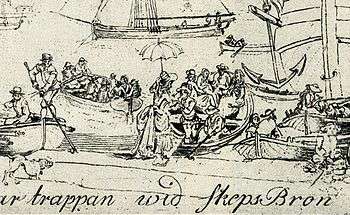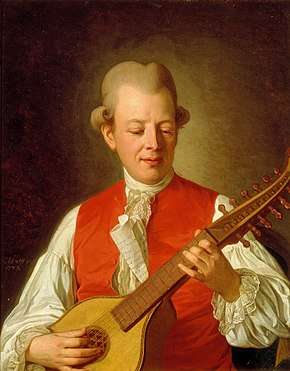Stolta Stad!
Stolta stad! (Proud city!), is one of the Swedish poet and performer Carl Michael Bellman's best-known and best-loved works, from his 1790 collection, Fredman's Epistles, where it is No. 33. It combines spoken sections (Was ist das?, with words in German, Swedish, and French) and song (in Swedish). It has been described as Swedish literature's most congenial portrait of its capital city.

The epistle is subtitled "1:o Om Fader Movitz's öfverfart til Djurgården, och 2:o om den dygdiga Susanna." (Firstly about father Movitz's crossing to Djurgården, and secondly about the virtuous Susanna).
Context
Carl Michael Bellman is the central figure in Swedish song, known for his 1790 Fredman's Epistles and his 1791 Fredman's Songs. He played the cittern, accompanying himself as he performed his songs at the royal court.[1]
Jean Fredman is a fictional character and the supposed narrator in Bellman's epistles and songs, based on a real watchmaker of Bellman's Stockholm.[2] The epistles paint a picture of the demimonde life of the city during the eighteenth century, where strong drink and beautiful "nymphs" like Ulla Winblad create a rococo picture of life, blending classical allusion and pastoral description with harsh reality.[1][2]
Epistle
The Epistle begins with a long spoken section, imitative of a crowded boat with people playing cards and others trying to move about; parts are in German and French.
| Stolta Stad! | Prose Translation |
|---|---|
| - Trumf i Klöver. - Där kommer Movitz. - Åtta och åtta gör mej Sexton, Fyra til så har jag Sjutton. - Mera Klöfver. - Sex och Sex är Tolf. - Åt du opp Hjerter Fru? - Ja du har vunnit. - Kors så du ser ut Movitz! - Nog känner jag igen Peruken; han har lånt Skoflickarens Peruk som bor midt emot Wismar i Kolmätar-gränd. - Lustigt! Basfiolen på ryggen, Tulpan på hatten, Valdhornet under armen, och Buteljen i fickan. - Stig i båten. - Hvad säjer den där gullsmidda Äppeltysken med Markattan på axeln? - Le diable! il porte son Violon, oui, par dessus l'épaule comme le Suisse porte la hallebarde. - Nu tar han til Valthornet. - Prutt, prutt, prutt, prutt. - Ach tu tummer taifel! Er ferschteht sich auf der musik wie ein Kuh auf den mittag. Movitz, bruder, willstu was Kirschen haben? - Stig i båten Susanna. Akta Köttkorgen. | - Trumps in Clubs. - There comes Movitz. - Eight and eight makes sixteen, Four more so I have seventeen. - More Clubs. - Six and six is twelve. - Have you taken the Hearts, woman? - Yes, you've won. - By the Holy Cross, you look like Movitz! - Probably I recognize the wig; he's borrowed the wig of that shoe girl who lives opposite the Wismar pub in Kolmätar Alley. - Funny! With his double bass on his back, tulip in his hat, French horn under his arm, and his [brandy-]bottle in his pocket. - Get in the boat. - What does that apple-German with the gold thread in his shirt and the monkey on his shoulder say? - Le diable! il porte son Violon, oui, par dessus l'épaule comme le Suisse porte la hallebarde.[lower-alpha 1] - Now he's going to play his French horn. - Bla, bla, bla, bla. - Ach tu tummer taifel! Er ferschteht sich auf der musik wie ein Kuh auf den mittag. Movitz, bruder, willstu was Kirschen haben?[lower-alpha 2] - Get in the boat Susanna. Mind out for the meat basket. |
The song has four verses, with two further spoken sections. Each verse has twelve lines, with the rhyming pattern AABBCCDDDEEE; of these, the lines AA both begin with Corno, horn, and all the lines CDD and EEE end with Corno; the first verse mentions Movitz, a musician, and one of the stock characters in Fredman's Epistles. The song is in 4
4 time in the key of A major, and is marked Marche.[3] The Epistle is dated 16 October 1771. Three of the spoken sections end with a mention that a "nymph", Susanna, is to sing; only this and No. 67 (Fader Movitz, bror) among the epistles call for a woman's voice, but the identify of "Susanna" is not known. The melody was said by Nils Afzelius to come from the aria "Regardez ces traits" from Pierre-Alexandre Monsigny's opera Le cadi dupé, but this is disputed by the musicologist James Massengale.[4][5]
| Stolta Stad! | Prose Translation |
|---|---|
| Corno. - - - Stolta Stad! Corno - - - Jag nu glad Förglömmer ditt prål, Ditt buller, larm och skrål, Dina Slott och Torn. Movitz blås i ditt horn - - - Corno Böljan slår, - - - Corno Båten går, - - - Corno Bland Jakter och Skutor Spanjefararn står Segelstinn - - - Corno Går snart in - - - Corno I Cadix och Dublin. - - - Corno | Proud City! I'm happy now Forgetting your ostentation, Your noise, alarm and rattle, Your Castles and Towers. Movitz blow your horn - - - The waves slap, - - - The boat goes, - - - Among yachts and small boats the Spain Merchantman stands The sail's tip - - - Is going in soon - - - In Cadiz and Dublin. |

Reception
The Epistle has been recorded by Fred Åkerström, Evert Taube,[6] and Peter Ekberg Pelz among others.[7] and Sven-Bertil Taube.[8][9] It has been performed in costume by Thord Lindé.[10]
Citing the Epistle, Anita Ankarcrona observes that Bellman was "the first, and perhaps the greatest, of all Stockholm depicters."[11]
The Bellman Society observes that Sweden's capital has never been portrayed with mightier trumpet blasts or more skilfully than in this Epistle, "Swedish literature's most congenial portrait of Stockholm." In its view, the work is neither poem nor song, but a song-drama of a kind created by Bellman himself out of a susurrus of voices around Skeppsbro. Soundscape, it suggests, turns into "a landscape painting, a stunningly beautiful snapshot of a Stockholm crowd in the 1770s".[12]
Writing in the Haga-Brunnsviken Nytt, Gunnel Bergström notes that in verse 3, Ulla Winblad climbs on board, and Movitz becomes randy.[13]
A tour company that shows people around Bellman's Stockholm has chosen the name "Stolta Stad".[14]
Notes
- In French: The devil! He's carrying his violin, yes, over his shoulder as a Swiss Guard carries his halberd.
- The original is in mock-phonetic German: Oh you schtupid deffil! He underschtands music like a cow at dinner. Movitz, brother, d'you vant some cherries?
References
- "Carl Michael Bellmans liv och verk. En minibiografi (The Life and Works of Carl Michael Bellman. A Short Biography)" (in Swedish). The Bellman Society. Retrieved 25 April 2015.
- Britten Austin, 1967. Chapter 3: Fredman's Epistles, pp 61-93.
- Bellman, 1790.
- "Epistel N:o 33". Bellman.net. Retrieved 23 March 2016.
- Massengale
- "Evert Taube Sjunger Och Berättar Om Carl Michael Bellman". Discogs. Retrieved 27 May 2019.
- Hassler, page 284.
- Hassler and Dahl, page 284
- Taube, Sven-Bertil. "Fredmans Epistel #33: Stolta Stad". YouTube. Retrieved 23 March 2016.
- Lindé, Thord. "Stolta Stad (epistel no.33)". YouTube. Retrieved 23 March 2016.
- Ankarcrona, Anita. "Stockholm: Bellmans stad - och vår" (PDF). Royal Swedish Library (Kungliga biblioteket). Retrieved 23 March 2016.
- Nilsson, Hasse. "Om Fredmans epistlar och sånger". The Bellman Society. Retrieved 23 March 2016.
- Bergström, Gunnel (October 2015). "Bellmans sångdramatik" (PDF) (3). Haga-Brunnsviken Nytt. Retrieved 23 March 2016.
- "Bussrundturer - utflykter med Stolta stad". Stolta Stad. Retrieved 23 March 2016.
Sources
- Bellman, Carl Michael (1790). Fredmans epistlar. Stockholm: By Royal Privilege.
- Britten Austin, Paul (1967). The Life and Songs of Carl Michael Bellman: Genius of the Swedish Rococo. New York: Allhem, Malmö American-Scandinavian Foundation. ISBN 978-3-932759-00-0.
- Britten Austin, Paul (1999) [1990]. Fredman's Epistles and Songs. Stockholm: Proprius.
- Hassler, Göran; Peter Dahl (illus.) (1989). Bellman – en antologi [Bellman – an anthology]. En bok för alla. ISBN 91-7448-742-6. (contains the most popular Epistles and Songs, in Swedish, with sheet music)
- Hassler, Göran; Peter Dahl (illus.) (1989). Bellman II – en antologi [Bellman – an anthology]. En bok för alla. ISBN 91-7448-837-6.CS1 maint: uses authors parameter (link) (contains the remaining Epistles and Songs, in Swedish, with sheet music)
- Kleveland, Åse; Svenolov Ehrén (illus.) (1984). Fredmans epistlar & sånger [The songs and epistles of Fredman]. Stockholm: Informationsförlaget. ISBN 91-7736-059-1.CS1 maint: uses authors parameter (link) (with facsimiles of sheet music from first editions in 1790, 1791)
- Massengale, James Rhea (1979). The Musical-Poetic Method of Carl Michael Bellman. Stockholm: Almqvist & Wiksell International. ISBN 91-554-0849-4.
